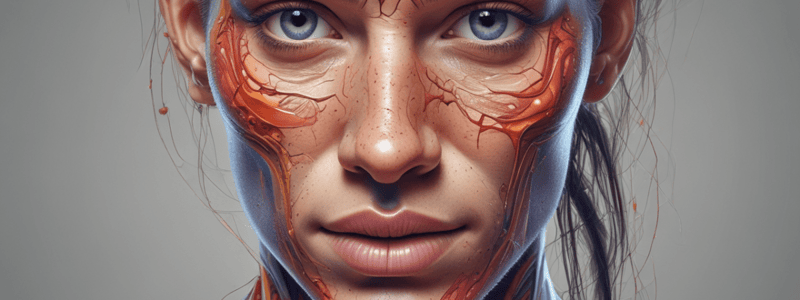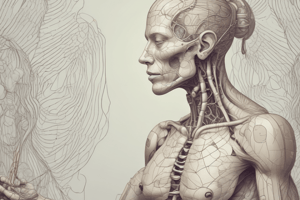Podcast
Questions and Answers
The human body consists of the head, neck, trunk, and legs.
The human body consists of the head, neck, trunk, and legs.
False (B)
The jaw framework is formed by the maxilla and the mandible.
The jaw framework is formed by the maxilla and the mandible.
True (A)
The thoracic cavity is located below the abdominal cavity.
The thoracic cavity is located below the abdominal cavity.
False (B)
The forehead is also known as the occiput.
The forehead is also known as the occiput.
The kidneys are located in the abdominal cavity.
The kidneys are located in the abdominal cavity.
The brain is located in the abdominal cavity.
The brain is located in the abdominal cavity.
The thigh, leg, and foot are segments of the upper extremities.
The thigh, leg, and foot are segments of the upper extremities.
The neck connects the head to the trunk.
The neck connects the head to the trunk.
Each hand has five fingers and a thumb.
Each hand has five fingers and a thumb.
The cheeks and ears are only found on one side of the head.
The cheeks and ears are only found on one side of the head.
The shoulder blades are located in the upper region of the back.
The shoulder blades are located in the upper region of the back.
The heart is located laterally in the thoracic cavity.
The heart is located laterally in the thoracic cavity.
The face extends from the chin to the forehead.
The face extends from the chin to the forehead.
There are 5 cervical vertebrae in the neck.
There are 5 cervical vertebrae in the neck.
The peritoneal cavity contains the kidneys.
The peritoneal cavity contains the kidneys.
The pelvic cavity contains reproductive organs in both males and females.
The pelvic cavity contains reproductive organs in both males and females.
The skull has three parts: frontal, lateral, and top.
The skull has three parts: frontal, lateral, and top.
All tissues of the body appear to be derived from four primitive cell types.
All tissues of the body appear to be derived from four primitive cell types.
The mouth is formed by two jaws: maxilla and mandible.
The mouth is formed by two jaws: maxilla and mandible.
A system in the human body is composed of different structures.
A system in the human body is composed of different structures.
Parenchyma is the specialized working tissue of an organ.
Parenchyma is the specialized working tissue of an organ.
Stroma is the most evolved supporting tissue holding the parenchyma together.
Stroma is the most evolved supporting tissue holding the parenchyma together.
All organs of the body are composed of five types of tissue.
All organs of the body are composed of five types of tissue.
Epithelial tissues include false epithelium such as the outer layer of the skin.
Epithelial tissues include false epithelium such as the outer layer of the skin.
Mechanical tissues are mainly composed of cells rather than ground substance.
Mechanical tissues are mainly composed of cells rather than ground substance.
Muscular tissues are made up of four types of highly specialized cells.
Muscular tissues are made up of four types of highly specialized cells.
Nervous tissue arises in the embryo from a different layer than the outer skin.
Nervous tissue arises in the embryo from a different layer than the outer skin.
The nervous tissue forms only part of the nervous system.
The nervous tissue forms only part of the nervous system.
Muscular tissues include smooth-muscle cells, cross-striated muscle cells, and heart-muscle cells.
Muscular tissues include smooth-muscle cells, cross-striated muscle cells, and heart-muscle cells.
Epithelial tissues have loosely packed cells with abundant ground-substance.
Epithelial tissues have loosely packed cells with abundant ground-substance.
The thorax extends from the shoulder to the waist.
The thorax extends from the shoulder to the waist.
The heart is located in the thoracic cavity.
The heart is located in the thoracic cavity.
The kidneys are situated in the abdominal cavity.
The kidneys are situated in the abdominal cavity.
The lower extremities consist of the thigh, leg, and foot.
The lower extremities consist of the thigh, leg, and foot.
Each hand has six fingers and a thumb.
Each hand has six fingers and a thumb.
The peritoneal cavity includes the stomach, spleen, and liver.
The peritoneal cavity includes the stomach, spleen, and liver.
Nervous tissue forms only a small part of the human body.
Nervous tissue forms only a small part of the human body.
The shoulder blades are also known as the collarbones.
The shoulder blades are also known as the collarbones.
The trunk is divided into three parts: thoracic, abdominal, and pelvic.
The trunk is divided into three parts: thoracic, abdominal, and pelvic.
The upper extremities are attached to the trunk by the coxal joint.
The upper extremities are attached to the trunk by the coxal joint.
The human body consists of the head, neck, trunk, and extremities.
The human body consists of the head, neck, trunk, and extremities.
The teeth, gums, and tongue are located inside the mouth in the oral cavity.
The teeth, gums, and tongue are located inside the mouth in the oral cavity.
The skull comprises three parts: frontal, lateral, and top.
The skull comprises three parts: frontal, lateral, and top.
The neck contains 7 cervical vertebrae which give it mobility.
The neck contains 7 cervical vertebrae which give it mobility.
The face extends from the forehead to the chin.
The face extends from the forehead to the chin.
The brain is located inside the cranial cavity.
The brain is located inside the cranial cavity.
The thorax, abdomen, and pelvis are parts of the human trunk.
The thorax, abdomen, and pelvis are parts of the human trunk.
The maxilla is the upper jaw which is immobile.
The maxilla is the upper jaw which is immobile.
The vertex and occiput of the head are covered with hair.
The vertex and occiput of the head are covered with hair.
The cheeks and ears are asymmetrically distributed on each side of the head.
The cheeks and ears are asymmetrically distributed on each side of the head.
All organs of the body are built up of four types of tissue.
All organs of the body are built up of four types of tissue.
Nervous tissue arises from a different layer than the outer skin in the embryo.
Nervous tissue arises from a different layer than the outer skin in the embryo.
Mechanical tissues are mainly composed of cells rather than ground substance.
Mechanical tissues are mainly composed of cells rather than ground substance.
Muscular tissues are made up of three types of highly specialized cells.
Muscular tissues are made up of three types of highly specialized cells.
Epithelial tissues have loosely packed cells with abundant ground-substance.
Epithelial tissues have loosely packed cells with abundant ground-substance.
Parenchyma is the specialized working tissue of an organ.
Parenchyma is the specialized working tissue of an organ.
Stroma is the most evolved supporting tissue holding the parenchyma together.
Stroma is the most evolved supporting tissue holding the parenchyma together.
Epithelial tissues include true epithelium such as the outer layer of the skin.
Epithelial tissues include true epithelium such as the outer layer of the skin.
The cells of epithelial tissues are closely packed with little ground-substance.
The cells of epithelial tissues are closely packed with little ground-substance.
Muscular tissues include bone, cartilage, and connective tissues.
Muscular tissues include bone, cartilage, and connective tissues.
Flashcards are hidden until you start studying




